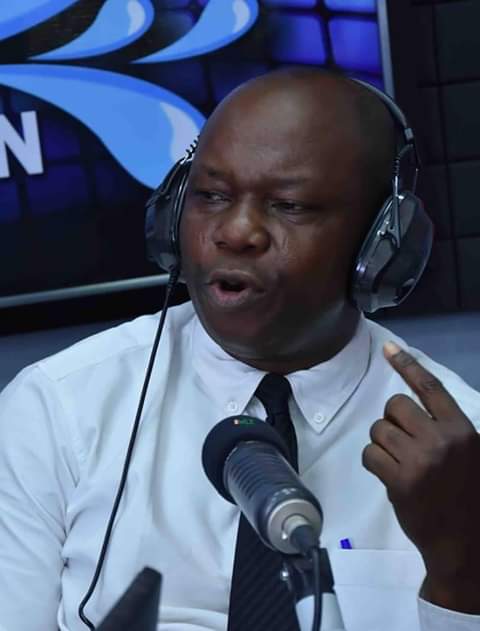

Media frenzy over the death of Tim Goke, a 37-year old man whose remains were found in a hotel, had been very huge and unsettling. As Police Detective and Head of its Legal Division, Muhammadu Kura sat on the swivel chair in his office at Kam Salem Police Headquarters this Wednesday afternoon, he reflected on his encounter with the Inspector General of Police about 40 hours back. The media had literally dragged the IG off his fanny to begin to take drastic actions.

The social media had already given its own judgment, hanging accused persons on the crucifix. It alleged a cover up in the offing by top echelon of the police, in cahoots with the accused, about seven of them. A section of the media even claimed that the owner of the hotel, one Chief Adetayo Ola, was a political godson of one of the bigwigs in Nigeria’s ruling party. In an apparent move to deflect the arrows being daily shot at the police, the IG had summoned Kura to his office and literally threw the huge file that contained all the investigated details of the death at him.

As Kura wondered what this whole drama was all about, the Inspector General had thundered in a baritone: “The President of the Republic has been inundated with calls about this case. There are allegations that we wanted to cover up evil doers. Pathologists have said that Tim Goke probably died of natural causes and we won’t have a case against the accused in court. Kura, you are a wizard in criminal law, apart from being one of the best detectives police in Nigeria today. I am interested in charging the accused to court. Go through the file and give me your recommendation in 48 hours. Thank you and have a good day.”
Muhammadu Kura was indeed police’s best investigator and lawyer. With a Master’s degree in Criminology from the Ahmadu Bello University, Zaria, the 42-year old Kanuri-born Superintendent of Police was also a lawyer, his turf being Criminal Law. He had spent the last 40 hours literally fasting but smoking like a chimney. He pored through the huge file of documents, acquainting himself with the facts of the case and making notes. As he sat on the swivel chair, beads of sweat stubbornly glided from his bushy head, making a puddle on his table, even as the air conditioner whooshed like a silent accomplice. At a point, Kura stood up, headed for his pack of Marlboro cigarettes, selected one and with an unruly hand, gummed one on his flabby lips and lit it up. He took an urgent drag, puffed a huge pall of smoke out which hit the ceiling as if in a rebellious slap.
From his jukebox sang Jamaican reggae music idol, Bob Marley’s Small Axe track. Kura intensified his smoking as he listened to the song which seemed to instigate him to want to get to the bottom of the investigation. Marley’s voice, as if specifically ministering to him, wafted into his ears: “Why boasteth thyself, Oh, evil men//Playing smart And not being clever?//Oh no, I said, you’re working iniquity//To achieve vanity//But the goodness of Jah, Jah I-dureth forever//If you are the big tree//We are the small axe//Sharpened to cut you down…Ready to cut you down//These are the words//Of my master, keep on tellin’ me//No weak heart//Shall prosper…//And whosoever diggeth a pit, Lord//Shall fall in it, shall fall in it//Whosoever diggeth a pit//Shall bury in it, shall bury in it…”


The facts of Tim’s death were already in the public domain. A postgraduate student of a university in the town where he was allegedly killed, he had lodged in the hotel named Valley. In a very curious twist, the hotel management had made all attempts to hide the fact of his lodgment with it. It was only when police investigations found this out that the receptionist, the first suspect in the case, and other accomplices, led police officers to a bush where Tim was buried. This led to the arrest of the alleged accomplices and owner of the hotel, Chief Adetayo with huge allegations made that Tim might have been used for rituals. The alibi of the receptionist suspect and other alleged accomplices was that, they had found Tim dead early in the morning of the second day of his lodgment and had spirited his corpse to the outskirts of the city to hide linkage of his death to the hotel.
Kura then brought out a copy of the autopsy report conducted on Tim’s body and began to examine it. Three pathologists and four other medical experts participated in the four-hour autopsy that took place in the Department of Morbid Anatomy of the University Teaching Hospital of the state where the death took place. The report claimed that Tim died of ‘severe trauma’ but that medicine could not ascertain the cause of death because his remains were at advanced stage of decomposition. However, Tim’s internal and external organs were said to be untouched. The reports however said that the femur of the deceased was found to have had a “sub-capital fracture.”
For almost an hour, the top police officer ruminated on the autopsy report. While medicine doubted the cause of Tim’s death, Kura wondered if law could doubt why he died. The first point of attraction for him was the broken femur of Tim’s body. What could have led to the fracture? Granted that pathologists claimed that the internal and external organs of the deceased were untouched, were they aware that in the occultic world, the blood of the victim was as germane to rituals more than any other part? He remembered he had read about rituals involving blood which have been in existence for many centuries which still lingered into the 21st century.
Five hundred years ago, the Aztecs, a Mesoamerican people who flourished in central Mexico during the post-classic period from 1300 to 1521.were involved in blood rituals between 1376 and 1521 AD. They sacrificed blood as offering to the Sun God. To them, death was part of life, just like birth. By spilling blood meant for rituals, they believed that the gods would compensate them by giving them bountiful crop yields, healthy and long lives. In India, it is believed that the individuals receiving shed blood are given more time to live by the gods. Thus, in Africa too, many engage in rituals so that they could have long life, prosperity and wellbeing. With these in mind, Kura wondered why the pathologists failed to see a probable nexus between the broken femur where blood could have been drained and the cause of the killing of Tim.
He instantly remembered a murder case that the police handled in Ado Ekiti, Ekiti State in August, 2017. A 73-year-old pensioner, Mrs. Adetutu Ajayi, was killed at her residence, No 10, Moferere, Ajilosun area by unknown assailants. Upon killing her, while they made away with her fingers, her blood was drained and taken away in her own bucket. Ajayi was daughter of a former Accountant General of the Old Western Region, Mr. Samuel Sotoowa.
Still puffing crazily at his cigarette, Kura walked to the bookshelf in his office and brought out one of his text books on Criminal Law. He flipped the pages to a section called Circumstantial Evidence and began to read like one readying for an examination. The case that came to his attention was Adepetu v The State which lawyers always cite in justifying circumstantial evidence. It was the case of one Olusola Adepetu, a renowned herbal traditional practitioner in Oyo State in the 1990s whose herbal enterprise went by the name, Olusola Naturalist Hospital. He was a major precursor of the trade, with high public awareness on the radio arm of the Oyo State Broadcasting Corporation.
Adepetu had been befriending one Miss Ranti Moradeyo and on the night of November 20, 1990, had gone to the lady’s house, picked her to God-knows-where. She was never seen alive thereafter. The next day, her corpse was found in the Sanyo area on the Lagos-Ibadan highway. Whoever placed it there wanted vehicles to have mutilated the body in pieces, so that the fact of severance of her body parts for rituals would be hidden for life. Adepetu was subsequently charged to the Oyo State High Court and the trial judge, piecing together circumstantial evidence, including the doctrine of “the last seen,” had convicted Adepetu according to Section 319(1) of the Criminal Code Cap 30 Laws of Oyo State 1978. He was sentenced to life imprisonment. Prosecution had called 19 witnesses. Following an overruling of the defence’s no-case submission, Adepetu gave evidence and called a single witness. The Appellate Court and the Supreme Court affirmed the judgment, leading to Adepetu spending about 25 years in the Kirikiri Prison.
Circumstantial evidence, from what Kura read, is observed where “no direct evidence of an eyewitness to the commission of an offence is available.” The court then “may infer from the facts proved, the existence of other facts which logically and conclusively establish the guilt of the accused person beyond reasonable doubt. Accordingly, when strong circumstantial evidence is led against an accused in a criminal trial and this gives rise to an inference irresistibly warranted by such evidence, the criminal court will not hesitate to make such inference as long as it is so cogent and compelling as to convince the jury that on no rational hypothesis other than the inference can the facts be accounted for.” Reading further, Kura learnt that the criminal liability of an appellant “was based on the natural consequence of his act or omission. Intent may also be proved positively by proof of the declaration of the accused as to his intent or inferentially.”
With all that Kura had gathered in the last 47 hours, he stood up like a drunk tottering on his drunken feet. He had literally known no sleep within the last two days or so. He momentarily peered into his strapless wrist watch and discovered he had less than an hour to address the Inspector General. In a sprint-like dash, he hopped into the elevator of the Police headquarters and with a fidgety hand, pressed the last floor button that would take him to the zenith of the high rise building.
The IG was expecting him. He sat cupped in a chair by his conference table, his cap removed, showing an acute baldness with shards of grey hairs that looked like icing on a black cake surrounding his head.
Waffling initially but quickly picking himself up, SP Kura began: “Circumstantial evidence says it’s murder, sir and we can sustain the charge. The circumstances are indubitable and they all point at conspiracy to murder and murder. The chain of circumstances is this, sir: Immediately Tim Goke entered Valley Hotel and paid N37,000 to the receptionist, the plot began. Oblivious of the power of technology and fate that made him call his wife as he was entering the hotel, the conspirators assumed that the fact of where he lodged would be concealed from investigators. Unfortunately, his account details revealed the payment. When detectives came to the hotel, the receptionist denied that Tim ever lodged there. It was upon interrogation that she spilled the beans and revealed other suspects.
“While the suspects’ alibi was that they found his dead body the next morning and shoveled it into the bush to disconnect the hotel from his death, it doesn’t add up and feeds into the line of a perfectly orchestrated conspiracy. If the fear of the dis-advertisement or bad publicity that a dead lodger would give the hotel were to be the major reason for their abstruse action, they should have known that in this modern age, since they purportedly didn’t have a hand in the death, an autopsy would have exonerated the hotel. Going to the length and the risk of taking Tim’s body to the bush is suspiciously incriminating enough and the circumstance pointing at murder and conspiracy. Again, as James Hadley Chase says that criminals always leave traces, no matter how small, these ones buried their victim with the bed sheet of the hotel and like the Ranti Moradeyo lady’s corpse in Adepetu v The State, they apparently believed Tim’s body would never be found.”
Kura picked a bottle of water on the Inspector General’s table and without prompting, poured it into his dry throat.
“I interviewed a pathologist who told me that the “severe trauma” in the pathologists’ report is ambivalent and could as well mean that the deceased was hit with an object leading to his death. According to him, the decomposition of the internal organ could be as a result of a corrosive acid intentionally poured into the deceased’s mouth at death. The mark found by pathologists on his neck cannot be accidental as well. It could mean that he was strangled. If we had the carbon dating technology in Nigeria, it would have been easier to determine whether the wound on the remains’ neck was pre or after death. Tim was healthy, from evidence we gathered and not suffering from any illness. He was said to have attended a meeting in Akure, hale and hearty.
“The disappearance of a major suspect in the alleged crime, said to be Chief Adetayo, the hotel owner’s son and one who allegedly participated in the process of taking Tim’s body into the forest, is a circumstantial thread that may link his father to the committal of the crime. We must ensure we bring him to book. We must get mobile phone service providers to give us Chief Adetayo’s call logs and all Chief’s call and discussions between the time Tim arrived the hotel and the time of the disposal of his corpse. How frequently did he speak with his son or any of the accused? What did they discuss? It is arrant nonsense to say that just because somebody was a typical Nigerian big man who established universities and big hotels, he cannot be steeped in occultic practices. Indeed, more than half of Nigerian big men are ritualists – from politicians, to judges, to you-name-them,” Kura said.
While rounding off his submission, he said: “Inspector General sir, facts of circumstantial evidence tell me that we have a good case if we charge the hotel owner and the other accused to court for conspiracy and murder. We should not allow the image of the Police Force to be further dented by pussy-footing in walking to the justice chambers.”
As he did this, in a queer manner that suggested his belief in his submission, Kura stood up from his seat, made the traditional police salute in obeisance to the Inspector General, headed for the door and slammed it shut behind him.
Bisi Akande’s Ila Orangun ‘Secretarial’ house
While the gale of deconstruction of My Participations, an autobiography of Chief Bisi Akande, former governor of Osun State and pioneer National Chairman of the All Progressives Congress, (APC) was going on last week, the photograph of another skyscraper property of his, built during his governorship of Osun and located in his hometown, Ila Orangun’s central market, went viral. It is different from the one that Baba Ayo Adebanjo queried where he got the money to build which one of my friends likened to a General Hospital in its humongous architectural arrogance. The Ila Central Market property, a four-storey building of five floors, bore the paterfamilias of power and majesty. Apparently, those who began weaving the narrative on the social media meant to show that in Akande, who claimed to be incorruptible in the book, and who, pre-My Participations, was held to be saintly, there was an Ayi Kwei Armah’s “the beaufyful ones” who are not yet born.
On seeing the photograph, it reminded me of two almost similar incidents like this which took their roots from musical lines of late Apala music legend, Ayinla Omowura’s panegyrics for his patrons. One was a tribute he did in 1973 in one of his vinyl to Akanni Tijani, also known as Mufutau Baba Owo, alias Muhammadu. According to Omowura in the song, when he saw the house Tijani had just built, he assumed that it was a “secretarial” – Secretariat, he meant.
Apparently after Tijani built the house, allegations started making the rounds that he was an armed robber and he enlisted Omowrura to do an image clean-up for him. So while singing to launder the butcher, Ayinla sang that Akanni was a butcher who killed two cows for sale on daily basis. “Akanni ki se robbery, malu meji lo nsubu l’Odo eran…” Ayinla took his incredulity to high heavens because it was only secretariat buildings that were built in that byzantine fashion.
Another patron of Omowurra’s who he sang his praises but which boomeranged the way Akande’s book is doing today is Captain Eweje. Said to be of the pay office of the Nigerian Army, Omowura got him into trouble in a vinyl where he asserted that Eweje’s wealth was out of this world and that whenever he desired to build a house, he took contractors abroad to see the architectural designs of his heart desire. Being a time when public officers were expected to maintain decorum in perception and reality, that song allegedly got Eweje out of the Army.
Like Eweje, Chief Akande’s Secretarial house is causing him a lot of public troubles. If Baba hadn’t written the autobiography, he perhaps could have gone down in history as one of the most incorruptible men to administer Nigeria. My Participation put paid to all that mis-representation.














